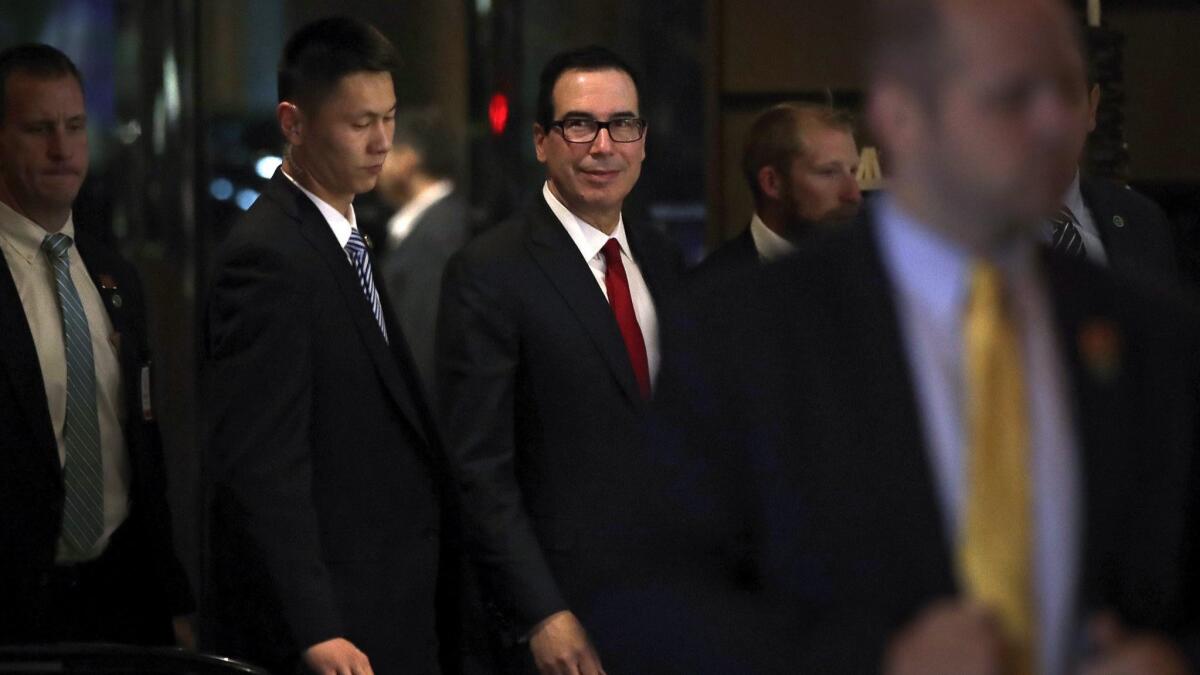U.S. hits China with trade demands, but leaves Beijing with little to show

- Share via
Reporting from Beijing — President Trump’s economic advisors left Beijing on Friday with few apparent gains, accentuating the hurdles facing the world’s two largest economies as they careen toward a trade war.
Both sides recognized that “major differences” remain, China’s state-run Xinhua News Agency said in a terse statement Friday afternoon. But they “reached consensus in some areas” and agreed to maintain communication.
The U.S. delegation, led by Treasury Secretary Steven T. Mnuchin, made a quick exit Friday evening without holding a news conference. Few analysts expected a breakthrough, but neither side held up even token wins. It remains unclear whether the U.S. will feel satisfied enough to delay an impending tariffs on $150 billion in Chinese goods.
“How could there be a negotiation in two days?” said Ashley Qian Wan, China economist for Bloomberg Economics in Beijing. “The U.S. came to give an offer and see if China would take it or not.”
U.S. officials sent a list of hefty requests ahead of Thursday’s meetings. They demanded China shrink its trade surplus $200 billion by the end of 2020 and stop subsidizing its high-tech production, according to a document first confirmed Friday by the Wall Street Journal.
Even before the talks began, Chinese officials made it clear they wouldn’t concede on Trump’s desire to narrow the trade gap so dramatically or curb China’s plan to develop homegrown, cutting-edge industries.
“If trade wars are fought, China will inevitably suffer losses,” Xinhua said in a Wednesday commentary. “However, China has the political advantage of centralized and unified leadership, a huge domestic market as its support and the international community’s support for a multilateral trading system.”
Liu He, Xi’s top economic advisor, led a delegation that produced its own demands — including requests that the U.S. stop its investigation into China’s intellectual property practices and remove proposed tariffs.
But Liu had requested someone to talk to about the trade issue when he visited the White House in March. And this week for a few hours, at least, that happened.
“This might not be a negative thing,” said Jianguang Shen, chief economist at Mizuho Securities Asia in Hong Kong. “They’re starting to negotiate, to meet. They have a wish list, and the Chinese can react to that. It’s much better than not talking.”
Prior to the trip, even U.S. officials warned not to expect much. The White House jettisoned the legwork that usually goes into international visits and instead sent its entire team of trade advisors to Beijing for two days.
Mnuchin led a delegation with competing views on how to deal with China. The group included economic advisor Larry Kudlow, a free trade advocate, as well as Trade Representative Robert Lighthizer, trade advisor Peter Navarro and Commerce Secretary Wilbur Ross, who take a more hard-line approach to the country.
But the team does agree China has coerced American companies into handing over trade secrets and creating barriers that block entrance into its massive market. They fear the country will continue these practices and heavily subsidize key sectors, such as cloud computing and robotics, giving China control over the world’s most crucial technologies.
Chinese officials argue they’re simply trying to catch up. They view the economy’s transition from labor-intensive production to advanced manufacturing as essential for its development. America complained for years about Beijing’s actions, they argue, and now it’s the protectionist bully.
“You are dealing with two different types of demands,” said Chen Dingding, a professor of international relations at Jinan University in Guangzhou. “One is a trade deficit, and the other is about who will control the future of technology.”
Tensions climbed last month after Trump proposed tariffs on $50 billion in Chinese goods that target high-tech products, including medical devices and aircraft parts. China matched the U.S. with a list of tariffs that would hit Trump’s base, such as soybeans, tobacco and corn. Then Trump proposed tariffs on an additional $100 billion in goods.
Adding to the tensions, the U.S. released a report on Thursday revealing the trade gap with China spiked by 16% to more than $91 billion in the first three months of the year.
Chinese officials realize that, on this trip, “the U.S. gave very unreasonable and unacceptable arguments, which China will definitely decline,” Wan, the Bloomberg economist, said. “But it will make the following requirement more acceptable and reasonable for the Chinese leaders. So, it’s a strategy for negotiation.”
The delegation dined at the state guesthouse Thursday evening, but neither the U.S. Embassy nor state media indicated the high-level delegation met with Xi.
He spent much of Friday morning delivering a speech to commemorate the 200th anniversary of Karl Marx, widely considered the father of communism. Xi took the opportunity to made pointed references to global interdependence.
“Whoever rejects the world, the world will reject them,” he said, in a possible dig at the visitors.
The dispute poses a threat to Xi, who must navigate between building up his economy and averting a trade war that could cripple global markets. But it also presents a challenge for Trump, whose Republican Party could take a hit in the midterm elections if China acts on its proposed tariffs.
“Our great financial team is in China trying to negotiate a level playing field,” Trump tweeted Thursday as his advisors arrived.
The group’s ultimate success may appear, again, as a tweet.
Nicolu Liu in The Times’ Beijing bureau contributed to this report.
Meyers is a special correspondent.
Twitter: @jessicameyers
On high-stakes trip to China, U.S. officials confront tech along with trade
How ‘Made in China 2025’ became the real threat in a trade war
A victim of its own industrial success, China’s hanger capital is now just hanging on
More to Read
Sign up for Essential California
The most important California stories and recommendations in your inbox every morning.
You may occasionally receive promotional content from the Los Angeles Times.










